I was around 10 years old when I established some of my first campfire cooking skills. There were two distinct memories from those times which I suspect formed the basis of my campfire culinary career. The first was an early fall bowhunt for grouse in the pine sandhills a couple miles from our farmhouse in north-central Alberta. I vividly remember that hunt all these years later. I wore a blue nylon backpack and carried my little green fiberglass recurve bow. The stalk on that grouse was perfection in the mind’s eye of a 10-year-old. I had heard a grouse drumming and was sneaking slowly, following the contour lines of a large hill. It was mid-morning, and the fall sun was dappling the brown grassy openings amongst the ancient pines. I moved like a big cat on the savannah. (At least that is how I remember it.) I was closing in on what was once the distant drumming of a ruffed grouse. As I came around the side of a large tree, something brown and out of place caught my eye. A lone male grouse stood on his drumming log, 15 yards away. He was facing directly away from me, his attention focused elsewhere. Easing from around the trunk of the ancient evergreen, I came to full draw and let the arrow fly. It crashed into the back of the bird and after a mad dash and some final fluttering, the bush became quiet once more.
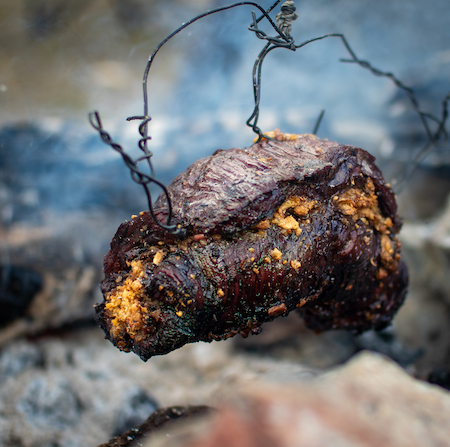
A culinary highlight from last fall. Stuffed
moose loin roasted over coals, hanging from a string.
I don’t recall everything in my pack that day, but I do remember a small, ivory-handled pocket knife that my grandfather had given me and a folded piece of tinfoil. A can of cream of mushroom soup, absconded from the farmhouse pantry, rounded out the necessities for a campfire meal that day. The grouse was lukewarm, stringy, and medium-rare at best. Yet it is a great memory, and an inaugural lesson in cooking with fire. There were many more to follow in the decades ahead. For me, the goal has always been to catch and cook stuff. I cannot explain this driving force inside of me. But it has always been there; a primordial instinct manifested by the hunt.
Campfire Cooking Skills I’ve Learned
The heat from flames is different than heat from coals. When I talk about campfire cooking, I don’t really mean cooking with fire. There is a huge difference! Flames are dirty. If you’ve ever seen an oil lantern with a wick too long or the same situation with a candle, you’ve noticed the black, sooty smoke that streams up from the flame. These are un-combusted gasses and impurities from the different components of the wax. Big flames on wood create the same effect. Smoke does create flavor. It gives bacon its wonderful aroma and flavor. We’ve all eaten smoked products like salmon and sausage. However, too much smoke, or worse, the wrong kind of smoke will give the food a horrible taste.
Dirty smoke from birch bark or pine sap will absolutely ruin a dish. We need to be cooking from the heat of charcoal or otherwise mostly combusted wood. This is pretty much pure heat, with little or no flavor being imparted into the food. From there, we can, if we want, introduce some good smoke from un-combusted and slightly damp fruit, nut, or other hardwood. When you want a smoky flavor for your campfire food project, just keep in mind that less is more.
Creating Cooking Coals
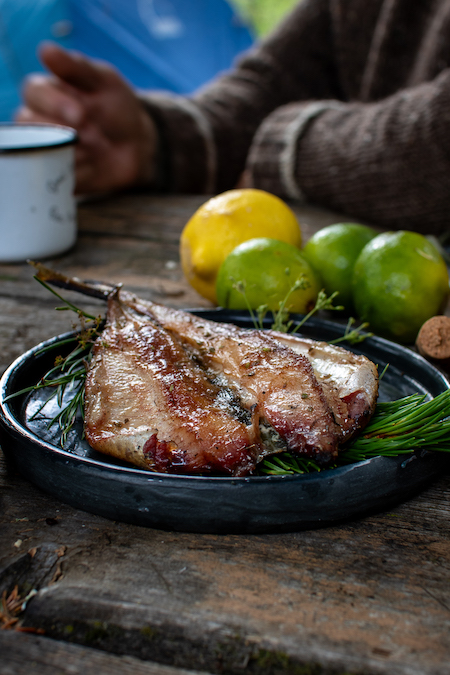
A smoker built from stacked rocks helped create this treat. Smoked Rocky Mountain whitefish on the
banks of the stream where they were caught.
There are three different ways you can go about creating cooking coals. I’ll save the easiest for last.
Lump charcoal and commercial briquettes. Perhaps this is the easiest solution. Traditional grilling, barbeque, and smokers all use lump and briquette-style charcoal to create the cooking heat they require. Prior to propane barbequing this was normal operating procedure. I have fond memories of the sights and smells of the “whoosh” of dad igniting the grill with lighting liquid-soaked briquettes. There are numerous methods for cooking over these chunks of ignited carbon other than dropping a match into the pile and cracking open a beer until they turn white.
Make your own charcoal. Here is a fun project that I’ve accomplished several times. All that is required is a metal container with a few holes drilled into the top. There are a few different ways to accomplish this, but the basic idea is to fill the container with chunks of hardwood or fruitwood and get it hot enough to gasify the wood and leave nothing but the carbon charcoal behind. I just set this bucket in the middle of a good, hot campfire and wait until the white smoke stops coming out of the holes. Then I lift the bucket out and set it aside to cool. But do not open the lid! A sudden introduction of oxygen at this stage could flare up into flames very quickly. Simply set the bucket somewhere safe and let it sit overnight. In the morning it will be filled with charcoal for your next grilling session. There are favorable woods to use in this process, hardwood makes the best charcoal though.
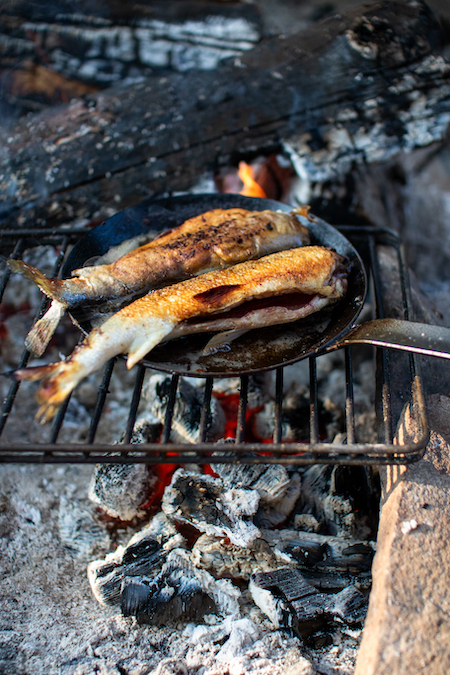
The classic fish in a fry pan. Butter. Salt. Score the skin with a sharp knife and don’t overcook!
Start a fire. This is the simplest way to create cooking coals and it’s what I do 99-percent of the time. Just start a campfire and set it up so that you can ‘harvest’ the coals as needed. So to accomplish this, my campfire is set up into two distinct areas. One is the charcoal creation area (the campfire), and the next is the cooking area. Almost always, I find some rocks which enable me to set up the grill to be relatively level. I have, however, recently acquired a campfire grill. It has folding legs and seems to work well. Eliminating the need for suitable rocks is handy, but on the other hand, I do like the fine-tuning that I can accomplish by adjusting the height of the grill with rocks and/or digging the coal pit slightly deeper.
Managing Cooking Heat
Alright, here we go. We have our fire which is generating the coals we need. We have our grill area. Lastly, we have our wild food ingredients, prepped, and ready to cook. The hard part is over really, but things can still go sideways quickly. It is easy to have either too much heat or not enough. Luckily though, this is incredibly easy to fix. With some sort of tool, most of the time for me it is a long stick or two, I can add or subtract coals under the grill. It really is just as simple as that.
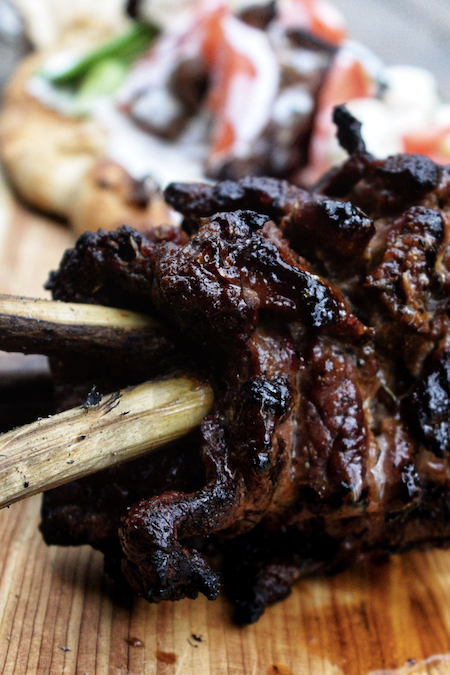
A favorite camp meal, Doner Kebabs. So simple to bring the fixings and then roast some marinated meat on a stick.
Listening, smelling, and watching whatever it is that you are cooking will tell you all you need to know about how cooking is progressing. Only experience will help you here. If you are anything like me, you will need to plate up charred and undercooked foods just often enough to become proficient in the process. I can offer you one little trick though. It is extremely common sense. If you have things set up slightly wrong, just think through the way to fix it. Recently, while cooking an entire chicken over a campfire in the Yukon, I needed to reduce the heat from the bottom of the hanging poultry and increase it near the top. Easy! I just placed an appropriately sized rock between the bird and the fire to solve the overcooking bit and then built up a ledge of rocks to place my coals higher up that cooked the chicken better on the legs.
I also tweaked the cooking process by placing some small rocks in the fire until they were nearly red-hot. A little beer in the cavity followed by the hot rocks cooked the chicken from the inside at the same time that the flames were doing their work on the outside. This system worked to perfection and was a beautiful way to share a meal with friends Alex and Erin.
At the beginning of this article, I mentioned that there were two childhood memories of campfire cooking experiences. The second one was at my grandmother’s house. She was a life-long member of the Girl Scouts, and gave me complete freedom, and a pack of matches, to make my own lunch outside in the bush. Into the willow windbreak, I happily trudged. I carried a plastic bag with a wiener and a hotdog bun. By the time I had finished eating a soot-blackened wiener in a sand-encrusted bun, I had learned a couple more valuable lessons about campfire cooking.
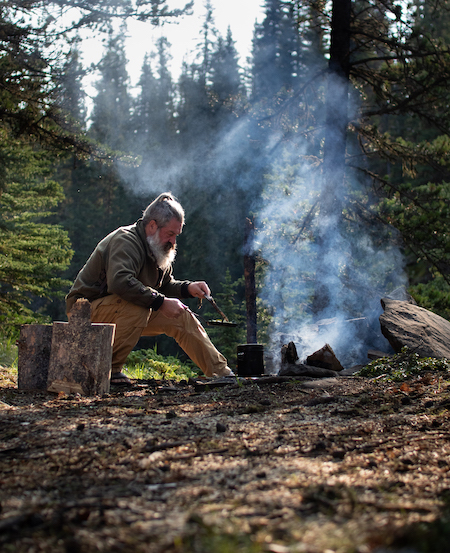
The author in a familiar setting, cooking for the crew over a campfire.
Cooking over fire has captured my fascination for decades now. From my earliest memories, this process, almost entirely, is what has driven me to want to hunt and fish. So if I can offer one more piece of advice, it is to let your kids responsibly play with fire. Maybe just quietly keep an eye on them. Obviously, you will give them the precautions to take and try to make them understand the consequences of fire accidents. But I am so grateful to my parents and grandparents for letting me have that freedom while growing up. It is an important life skill—cooking with fire.
John Schneider is the host of the podcast, A Traditional Bowhunter’s Journey, as well as the creator of the YouTube channel, John Schneider’s Wild Life. He is now living on a sailboat, exploring wild food on the Pacific Coast. He is a longtime traditional bowhunter, hunting guide, and fly-fisher.
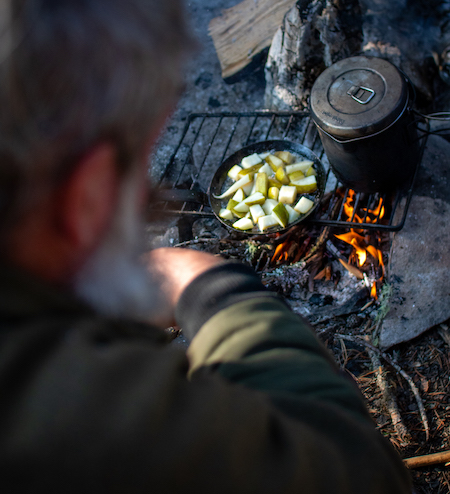
Even the desserts are cooked over a fire. Pears in a caramel sauce. Photo by Kevin Kossowan


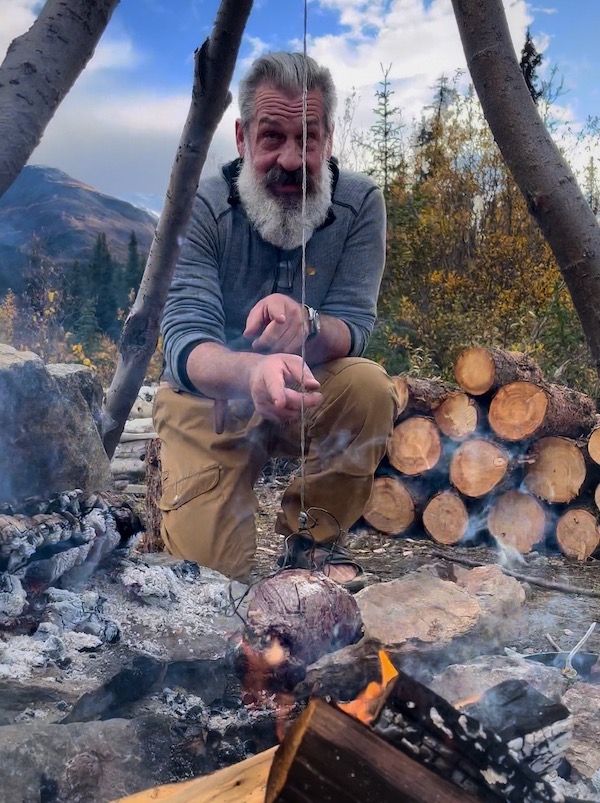




Leave A Comment